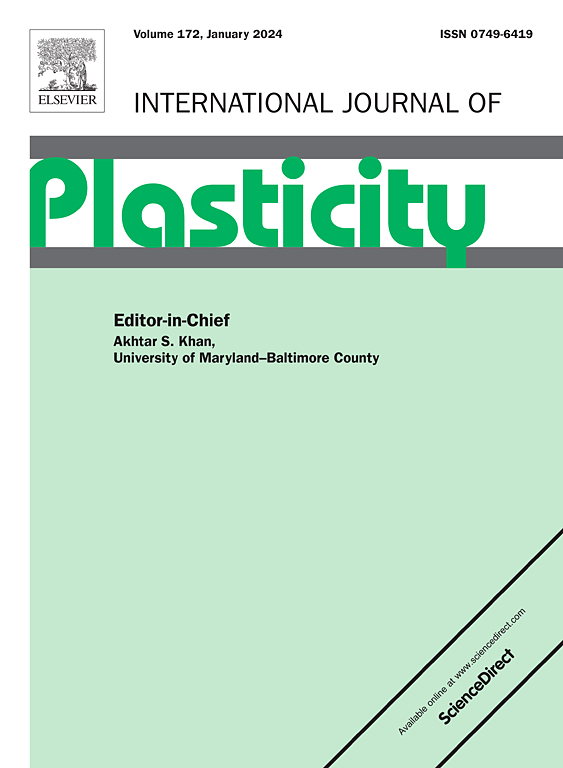A strain rate-dependent distortional hardening model for nonlinear strain paths
IF 12.8
1区 材料科学
Q1 ENGINEERING, MECHANICAL
引用次数: 0
Abstract
In this paper, a strain rate-dependent distortional hardening model is firstly proposed to describe strain rate-dependent material behaviors under linear and nonlinear strain paths changes in . The proposed model is formulated based on the simplified strain rate-independent distortional hardening model (Choi and Yoon, 2023). Any yield function could be used for the strain rate-dependent isotropic and anisotropic yielding. For the linear strain path, the strain rate-dependent isotropic hardening behavior could be explained by two state variables representing rate-dependent yielding and convergence rate of flow stress under monotonically increasing loading condition, respectively. For the nonlinear strain paths, the strain rate-dependent material behaviors such as Bauschinger effect, yield surface contraction, permanent softening, and nonlinear transient behavior could be described by modifying the evolution equations of the simplified strain rate-independent distortional hardening model with a logarithmic term of strain rate. For the verification purpose, it was used the strain-rate dependent tension-compression experiments of TRIP980 and TWIP980 (Joo et al., 2019). In addition, a high speed U-draw bending test was conducted with original and pre-strained specimens. The springback prediction in high speed U-draw bending test was performed by using strain rate-independent isotropic, strain rate-dependent isotropic-kinematic and distortional hardening models. It is identified that the proposed model showed the most accurate prediction for the pre-strained specimen where the possible bilinear and trilinear path change in is observed while it showed the same accuracy for the original specimen where main strain path change occur in forward-reverse manner ().
非线性应变路径的应变率相关变形硬化模型
本文首先提出了一个应变率相关的变形硬化模型来描述材料在0≤θpathchange≤180°线性和非线性应变路径变化下的应变率相关变形硬化行为。提出的模型是基于简化的应变速率无关的扭曲硬化模型(Choi和Yoon, 2023)。任何屈服函数都可以用于应变率相关的各向同性和各向异性屈服。对于线性应变路径,应变速率相关的各向同性硬化行为可以用单调递增加载条件下流变应力收敛速率和屈服速率相关的两个状态变量来解释。对于非线性应变路径,材料的包辛格效应、屈服面收缩、永久软化和非线性瞬态行为等与应变速率相关的行为可以通过将应变速率无关的简化变形硬化模型的演化方程修改为应变速率的对数项来描述。为了验证目的,采用了TRIP980和TWIP980应变速率相关的拉压实验(Joo et al., 2019)。此外,还对原始和预应变试样进行了高速u形拉伸弯曲试验。采用应变速率无关的各向同性、应变速率相关的各向同性运动模型和变形硬化模型对高速u形弯曲试验的回弹进行了预测。我们发现,所提出的模型对预应变试样在0≤θpathchange≤180°时可能出现的双线性和三线性路径变化的预测最为准确,而对主应变路径以正反方向变化的原始试样(θpathchange=180°)的预测同样准确。
本文章由计算机程序翻译,如有差异,请以英文原文为准。
求助全文
约1分钟内获得全文
求助全文
来源期刊

International Journal of Plasticity
工程技术-材料科学:综合
CiteScore
15.30
自引率
26.50%
发文量
256
审稿时长
46 days
期刊介绍:
International Journal of Plasticity aims to present original research encompassing all facets of plastic deformation, damage, and fracture behavior in both isotropic and anisotropic solids. This includes exploring the thermodynamics of plasticity and fracture, continuum theory, and macroscopic as well as microscopic phenomena.
Topics of interest span the plastic behavior of single crystals and polycrystalline metals, ceramics, rocks, soils, composites, nanocrystalline and microelectronics materials, shape memory alloys, ferroelectric ceramics, thin films, and polymers. Additionally, the journal covers plasticity aspects of failure and fracture mechanics. Contributions involving significant experimental, numerical, or theoretical advancements that enhance the understanding of the plastic behavior of solids are particularly valued. Papers addressing the modeling of finite nonlinear elastic deformation, bearing similarities to the modeling of plastic deformation, are also welcomed.
 求助内容:
求助内容: 应助结果提醒方式:
应助结果提醒方式:


